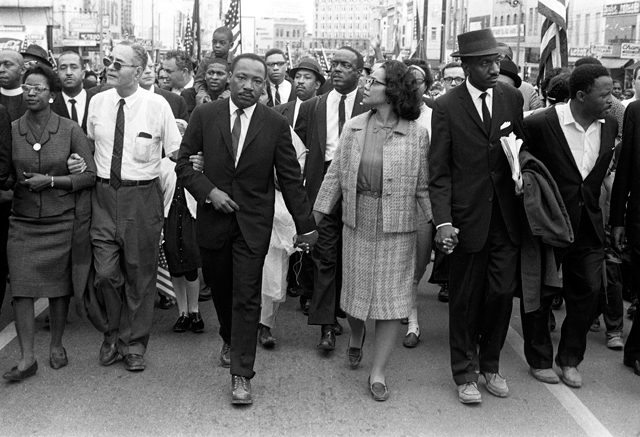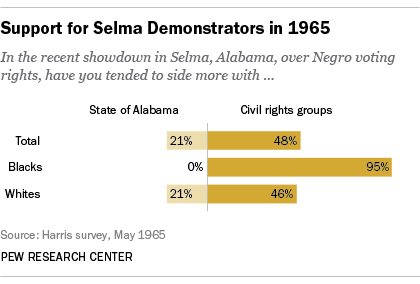
Andrew Kohut, the founding director of Pew Research Center and its president from 2004 to 2012, was one of the nation’s leading pollsters. He died in 2015. His work, over three decades, won him wide respect for his expertise and ability to craft stories about what people could learn from survey research. One of his particular talents was to reach back in time to take a snapshot of the mood of Americans in another era to show how much times had changed.
Here is one of those articles, originally published on March 5, 2015.

When civil rights activists led a bloody protest march in Selma, Alabama, on March 7, 1965, that is credited with helping to assure passage of the Voting Rights Act that year, civil rights was a top issue for the American public, but opinions about it were very mixed. Even so, America’s verdict on Selma was clear. In all, the protesters staged three marches that month, and polling showed the public clearly siding with the demonstrators, not with the state of Alabama.
A nationwide Gallup poll in February 1965 found 26% of Americans citing civil rights as a problem facing the nation, second only to the expanding war in Vietnam (cited by 29%). There was broad-based support for the war at this early stage in its history, but views about civil rights and integration were clearly mixed.
On one hand, Americans continued to support the Civil Rights Act of 1964, at least in principle, but had concerns about its scope and implementation. A Gallup poll in October 1964 reported that the public approved of the new law by nearly two-to-one (58% to 31%). And in April 1965, Gallup found a whopping 76% in favor of a then-proposed equal rights voting law.
But while the public supported civil rights legislation conceptually, they expressed concerns about the pace of its implementation. Indeed, although most supported the new civil rights law soon after it was passed, a national Opinion Research Corporation poll showed 68% of Americans wanting to see moderation in its enforcement, with only 19% wanting vigorous enforcement of the new law.
 In that light, it is not surprising that in early 1965, a Gallup poll found growing numbers of Americans saying that the Johnson administration was moving too fast overall on integration. In March, 34% held that view, and by May that sentiment rose to 45%, with only 14% expressing the view that it was not moving fast enough.
In that light, it is not surprising that in early 1965, a Gallup poll found growing numbers of Americans saying that the Johnson administration was moving too fast overall on integration. In March, 34% held that view, and by May that sentiment rose to 45%, with only 14% expressing the view that it was not moving fast enough.
Opinion about the pace of integration in May 1965 was dramatically different in the South compared with other parts of the country. By a margin of 61% to 21%, Southerners felt the government was moving too quickly, rather than about right. Outside the South, Americans were about evenly divided: About four-in-ten thought the pace was too fast and about the same percentage thought integration was occurring at about the right pace.
Gallup reported in February 1965 that, when asked about the Civil Rights Act specifically, 42% overall believed the federal government was moving too fast in guaranteeing “Negro” voting rights and the right of “Negroes” (the term used in the question) to be served in public places such as restaurants, hotels and theaters, while just 25% thought it was not moving fast enough.
 But despite all these reservations, views about what occurred in Selma were another matter. By a 48% to 21% margin, a Harris poll in May 1965 found its respondents saying they sided more with the civil rights groups involved than with the state of Alabama. Not unexpectedly, virtually all of the black respondents sided more with the demonstrators (95%), but the balance of opinion among whites was also clearly with them rather than with the state of Alabama (46% to 21%).
But despite all these reservations, views about what occurred in Selma were another matter. By a 48% to 21% margin, a Harris poll in May 1965 found its respondents saying they sided more with the civil rights groups involved than with the state of Alabama. Not unexpectedly, virtually all of the black respondents sided more with the demonstrators (95%), but the balance of opinion among whites was also clearly with them rather than with the state of Alabama (46% to 21%).
Note: For more about how contemporary Americans feel about achieving the goal of racial equality, see our report “Race in America 2019.”



